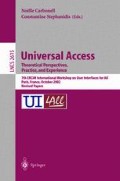Abstract
The E-cane is an electronic aid equipment for the visually impaired to widely detect the obstacles that normal white cane cannot reach. We propose a situation presumption algorithm, “Wall/Floor- strategy” for the E-cane, which is capable of detecting the presuming the condition of spot where the blind user is stepping into. When some obstacles are recognised, E-cane informs the user about the types of the obstacles;the walls, gaps, stairs and so on by vibration and voice. This paper presents our proto-type implementation and some experimental results, that show the effectiveness of the proposed system.
Access this chapter
Tax calculation will be finalised at checkout
Purchases are for personal use only
Preview
Unable to display preview. Download preview PDF.
References
Benjamin, J. M., Ali, N. A., and Schepis, A. F., 1973, “A Laser Cane for the Blind.” Proceedings of the San Diego Biomedical Symposium, Vol. 12, pp. 53–57.
Y. Bellik, R. Farcy, “Comparison of Various Interface Modalities for a Locomotion Assistance Device”, ICCHP 2002, 8th International Conference on Computers Helping People with Special Needs, University of Linz (Austria), 15–20 July, 2002.
Iwan Ulrich, Johann Borenstein, The GuideCane — Applying Mobile Robot Technologies to Assist the Visually Impaired: IEEE trans. on Systems, Man, and Cybernetics, part A:Systems and Humans, vol.31, No.2, pp. 131–136. (2001)
K. Goto, H. Matsubara, S. Myojo, A Guiding System for Persons Handicapped to Move: Proceedings vol.A of the third World Congress on Railway Research, pp.533–540, (1997).
J.E. Bresenham, Algorithm for computer control of a digital plotter: IBM Systems Journal 4(No.1) p. 25–30 (1965)
N. Molton, S. Se, J.M. Brady, D. Lee, P. Probert, A Stereo vision-based aid for the visually impaired: Image and Vision Computing, Vol, 16 pp. 251–263. (1998).
Author information
Authors and Affiliations
Editor information
Editors and Affiliations
Rights and permissions
Copyright information
© 2003 Springer-Verlag Berlin Heidelberg
About this paper
Cite this paper
Yasumuro, Y., Murakami, M., Imura, M., Kuroda, T., Manabe, Y., Chihara, K. (2003). E-cane with Situation Presumption for the Visually Impaired. In: Carbonell, N., Stephanidis, C. (eds) Universal Access Theoretical Perspectives, Practice, and Experience. UI4ALL 2002. Lecture Notes in Computer Science, vol 2615. Springer, Berlin, Heidelberg. https://doi.org/10.1007/3-540-36572-9_32
Download citation
DOI: https://doi.org/10.1007/3-540-36572-9_32
Published:
Publisher Name: Springer, Berlin, Heidelberg
Print ISBN: 978-3-540-00855-2
Online ISBN: 978-3-540-36572-3
eBook Packages: Springer Book Archive

